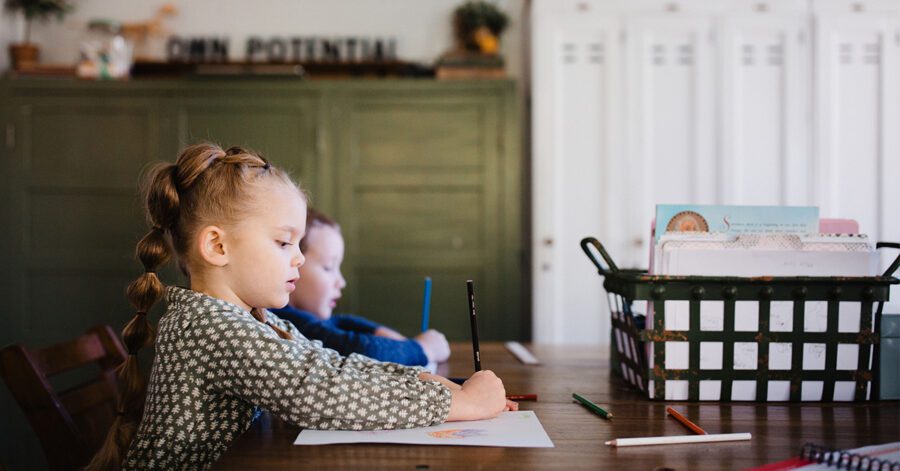A family culture of learning is one that goes beyond school, beyond books, beyond even practice. Instead, a culture of learning is restful, playful, and natural, built upon wonder and observation and a love of language. Here’s how one family cultivated a culture of learning in their home.
A Family Culture of Learning Inspires Wonder and Worship
One of my family’s favorite activities is taking evening walks in a nearby arboretum. We love watching the flowers eagerly surge in and out of season and observing the trees as they testify to both permanence and transience.
We each have beloved vistas along the way and deeply cherished trees—mine are the wild plum in spring; the fresh green ginkgo with its fan-like leaves that turn a brilliant, deep creamy yellow in the fall; the Osage orange with its thorns and unendingly fascinating coral-like fruit; the stately tulip poplar with its perfect blossoms in spring, striking foliage in summer, and fierce claws bared in fall and winter.
We stay long enough to watch the sunset, anticipating that breathtaking moment when Mars first becomes visible. We begin to hear bats softly clicking above us, and their lithe yet fragile forms are silhouetted against the almost-dark sky. Now we can see not only Mars but also Jupiter and our old friend Betelgeuse shining out of the fading sky as we wait for the rest of Orion’s form to materialize. Suddenly, Pollux and Castor’s heads are visible, and the North Star stands firm beside the Big Dipper, ready to guide the way.
One turn on the path leads us between the trunk of an oak that began life as a sapling just prior to the Revolutionary War. We always stop to marvel at what this tree must have witnessed before it finally fell across the path during an ice storm years ago.
And now we get to walk between the two halves of its arrestingly beautiful trunk, growth rings swelling from the center like ripples on a pond. A nearby marker plots major world events that occurred at various points along its circular timeline, and we enjoy noting events that overlap with our Foundations timeline and history sentences.
As our walk draws to a close and we circle back to the car, we stand in awe of the beauty of God’s creation. Our shared experience of wonder and worship has drawn us into closer communion with Him and with each other.
A Family Culture of Learning Is More Than “Doing School”
When we leave, it would impoverish the truth to say that we had been “doing school.”
Yes, we were learning—did you know that the collective noun for a group of titmice is a dissimulation or a banditry? Yes, we were reviewing—what makes Betelgeuse appear red again? That’s right, the red giant star has exhausted its hydrogen fuel and is slowly becoming a white dwarf star as it cools. Yes, we were observing—ha! Just as we had read once, sassafras trees really do have mitten-shaped leaves.
But our experience was so much more meaningful than any one of those things. To say we were doing school would diminish the vitality, the immediacy, the intensity of what had occurred. It would suggest that our purpose had been to learn, to review, and to observe when really what we desired when we set out was to marvel, to discover, to delight.
As we progress in our homeschooling journey, we find we are “doing school” less and less.
We are learning more than ever, but our learning has become more playful. Natural. Restful. Life-giving. Exciting.
This is possible for a few reasons.
A Family Culture of Learning Nurtures Familial Relationships
The first is relationship.
We have studied each other well. There was a phase a few years ago when learning was anything but life-giving. Somehow, parents and student had made some fundamental but inaccurate assumptions about the others’ needs and wants, and these assumptions colored many a school day dark, often leaving it streaked with tears and torn by misunderstandings.
One long summer afternoon, my daughter poured her heart out to me as we sat snuggled on the couch. She didn’t want summer to end because she loved the way we learned together in the summer, and she was afraid of the expectations we had grown to have of each other during the school year. I listened very attentively. I didn’t want a return to the relational tension of the school year, either.
We cried and occasionally chuckled together as we recounted the struggles of the previous year, and we agreed that we would work together to learn each other first and subject material second.
We committed to growing and preserving a healthy parent/child and teacher/student relationship above all. We would communicate immediately when we found that something wasn’t working and collaborate on a solution. We would learn like it was summer—like we were living in a home with our favorite people in the world, and we had been given the gift of a whole day to discover more about those people and that world together.
A Family Culture of Learning Revels in Language
The second reason that learning has come to feel natural and restful in our family is that we have chosen to live saturated in language, knowledge, and ideas. We delight in books, in audiobooks, in wordplay. Our walls are lined with an ever-growing collection of books, and we continually borrow stacks of books on every subject imaginable from the library. Our entire family finds intense pleasure in a well-turned phrase or a good pun; we will stop anything we are doing to listen to someone share a beautiful passage from a good book. We love chatting over new facts learned and ideas encountered on our walks, on drives, or over dinner.
Appreciation of language, knowledge, and ideas spills over the edges of our lives until, once again, as with our walks at the arboretum, there is no distinction between learning and living.
When my daughter was young, she developed a fascination with ancient mythologies, and the year she was four, we spent a sizeable fraction of each afternoon reenacting her favorite scenes from children’s retellings of these stories. Theseus and the Minotaur was her favorite. She also loved Beowulf, and I even took the opportunity to read to her some key passages from Seamus Heaney’s translation so she could soak in the beautiful language.
Even at four, she couldn’t contain her excitement at the poetic phrasing of the idea that “Beowulf began to speak” as Beowulf “unlocked his word-hoard.” She stopped me to say that she just loved the way the author phrased it, then sat quietly with shining eyes for a moment before singing a sweet, happy little song.
Only then were we ready to go on.
Some time ago, she was reading beside me while I dozed. She asked me what “aspiring” meant. I defined it, and we had a delightfully silly conversation. Before picking up her book again, we jotted down this poem in summary:
Don’t Unlock a Sleepy Word-Hoard!
The aspiring author lay prostrate,
perspiring—almost expiring—
under the weight of his desiring to be inspiring.
And the product?
A bespectacled befreckticled impractical pterodactycle
sitting erecticle as he deflecticled insecticles
(while enjoying a juicy schmeckticle)
and polishing his spectacular spatchacular
and flummoxing his multitudinous flatuludinous neighbors.
Here, we were reveling in language—playing with words, sounds, spelling, rhythm, and each other. The title was her homage to our experience of Beowulf years earlier, and the rest was pure joy and fun. We were inadvertently covering many important language arts concepts, but were we “doing school” in that rollicking, ridiculous conversation?
Certainly not!




